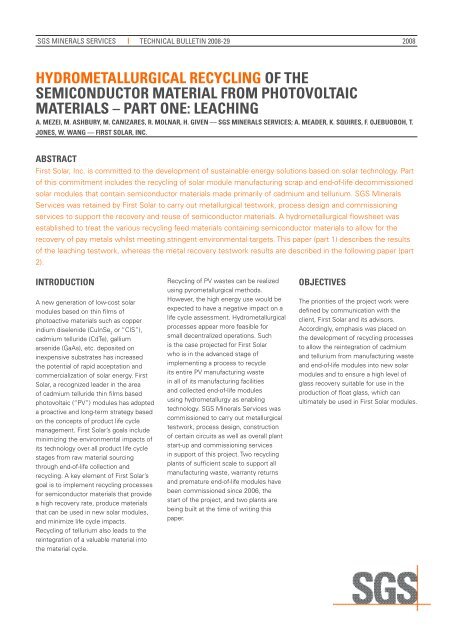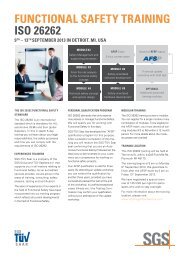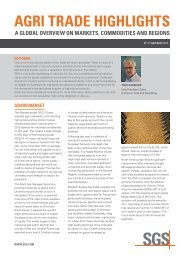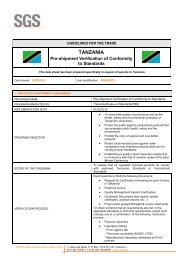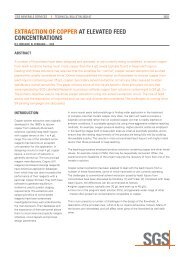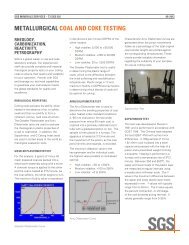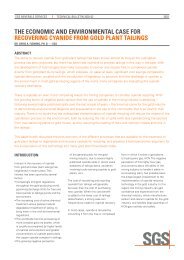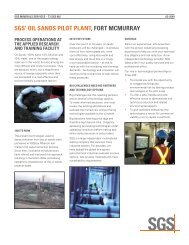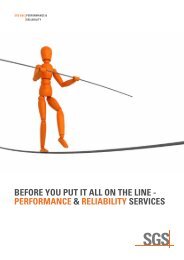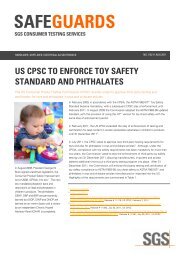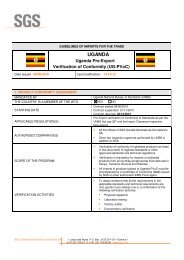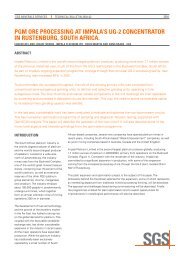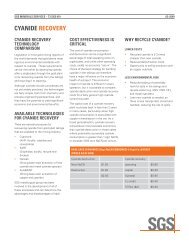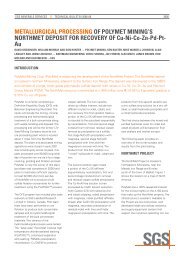Recycling Photovoltaic Materials - Part 1 - SGS
Recycling Photovoltaic Materials - Part 1 - SGS
Recycling Photovoltaic Materials - Part 1 - SGS
You also want an ePaper? Increase the reach of your titles
YUMPU automatically turns print PDFs into web optimized ePapers that Google loves.
<strong>SGS</strong> MINERALS SERVICES TECHNICAL BULLETIN 2008-29<br />
2008<br />
HYDROMETALLURGICAL RECYCLING OF THE<br />
SEMICONDUCTOR MATERIAL FROM PHOTOVOLTAIC<br />
MATERIALS – PART ONE: LEACHING<br />
A. MEZEI, M. ASHBURY, M. CANIZARES, R. MOLNAR, H. GIVEN –– <strong>SGS</strong> MINERALS SERVICES; A. MEADER, K. SQUIRES, F. OJEBUOBOH, T.<br />
JONES, W. WANG –– FIRST SOLAR, INC.<br />
ABSTRACT<br />
First Solar, Inc. is committed to the development of sustainable energy solutions based on solar technology. <strong>Part</strong><br />
of this commitment includes the recycling of solar module manufacturing scrap and end-of-life decommissioned<br />
solar modules that contain semiconductor materials made primarily of cadmium and tellurium. <strong>SGS</strong> Minerals<br />
Services was retained by First Solar to carry out metallurgical testwork, process design and commissioning<br />
services to support the recovery and reuse of semiconductor materials. A hydrometallurgical flowsheet was<br />
established to treat the various recycling feed materials containing semiconductor materials to allow for the<br />
recovery of pay metals whilst meeting stringent environmental targets. This paper (part 1) describes the results<br />
of the leaching testwork, whereas the metal recovery testwork results are described in the following paper (part<br />
2).<br />
INTRODUCTION<br />
A new generation of low-cost solar<br />
modules based on thin films of<br />
photoactive materials such as copper<br />
indium diselenide (CuInSe 2<br />
or “CIS”),<br />
cadmium telluride (CdTe), gallium<br />
arsenide (GaAs), etc. deposited on<br />
inexpensive substrates has increased<br />
the potential of rapid acceptation and<br />
commercialization of solar energy. First<br />
Solar, a recognized leader in the area<br />
of cadmium telluride thin films based<br />
photovoltaic (“PV”) modules has adopted<br />
a proactive and long-term strategy based<br />
on the concepts of product life cycle<br />
management. First Solar’s goals include<br />
minimizing the environmental impacts of<br />
its technology over all product life cycle<br />
stages from raw material sourcing<br />
through end-of-life collection and<br />
recycling. A key element of First Solar’s<br />
goal is to implement recycling processes<br />
for semiconductor materials that provide<br />
a high recovery rate, produce materials<br />
that can be used in new solar modules,<br />
and minimize life cycle impacts.<br />
<strong>Recycling</strong> of tellurium also leads to the<br />
reintegration of a valuable material into<br />
the material cycle.<br />
<strong>Recycling</strong> of PV wastes can be realized<br />
using pyrometallurgical methods.<br />
However, the high energy use would be<br />
expected to have a negative impact on a<br />
life cycle assessment. Hydrometallurgical<br />
processes appear more feasible for<br />
small decentralized operations. Such<br />
is the case projected for First Solar<br />
who is in the advanced stage of<br />
implementing a process to recycle<br />
its entire PV manufacturing waste<br />
in all of its manufacturing facilities<br />
and collected end-of-life modules<br />
using hydrometallurgy as enabling<br />
technology. <strong>SGS</strong> Minerals Services was<br />
commissioned to carry out metallurgical<br />
testwork, process design, construction<br />
of certain circuits as well as overall plant<br />
start-up and commissioning services<br />
in support of this project. Two recycling<br />
plants of sufficient scale to support all<br />
manufacturing waste, warranty returns<br />
and premature end-of-life modules have<br />
been commissioned since 2006, the<br />
start of the project, and two plants are<br />
being built at the time of writing this<br />
paper.<br />
OBJECTIVES<br />
The priorities of the project work were<br />
defined by communication with the<br />
client, First Solar and its advisors.<br />
Accordingly, emphasis was placed on<br />
the development of recycling processes<br />
to allow the reintegration of cadmium<br />
and tellurium from manufacturing waste<br />
and end-of-life modules into new solar<br />
modules and to ensure a high level of<br />
glass recovery suitable for use in the<br />
production of float glass, which can<br />
ultimately be used in First Solar modules.
<strong>SGS</strong> MINERALS SERVICES TECHNICAL BULLETIN 2008-29<br />
2<br />
With no previous example of<br />
commercially applied Cd/Te recycling<br />
technology, it was decided to produce<br />
the necessary data by the means<br />
of conventional hydrometallurgical<br />
testwork, involving several steps<br />
including:<br />
1. Recycle feed characterization;<br />
2. Base line and pre-optimization<br />
leaching tests;<br />
3. Purification tests;<br />
4. Cadmium and Tellurium recovery<br />
tests;<br />
5. Elaboration of conceptual flowsheet<br />
and design criteria.<br />
<strong>Part</strong> One presents data on items (1) and<br />
(2) from above and <strong>Part</strong> Two presents<br />
items 3 through 5.<br />
The results of the work currently in<br />
progress will be published at a later date.<br />
TESTWORK RESULTS OUTLINE<br />
RECYCLE FEED<br />
Of the cadmium entering into solar<br />
module manufacturing process, the<br />
following is a list of the plant outputs to<br />
which it reports:<br />
• final product, i.e. photovoltaic (“PV”)<br />
modules and in the form of cadmium<br />
telluride;<br />
• an intermediate product called “coater<br />
overspray” in the form of a cadmium<br />
telluride of varying purity;<br />
• the plant waste water treatment<br />
filter cake in the form of cadmium<br />
and tellurium precipitates, along with<br />
significant amount of impurities;<br />
• the photovoltaic (“PV”) scrap<br />
consisting of end of life modules and<br />
manufacturing scrap in the form of<br />
cadmium telluride containing trace<br />
amounts of metallic impurities,<br />
• Non-recoverable waste.<br />
<strong>Photovoltaic</strong> panels (PV) recycle-head<br />
samples<br />
The test samples were prepared by First<br />
Solar using its dry communition circuit<br />
part of the existing Perrysburg<br />
process.<br />
The recycle feed consisting of<br />
manufacturing scrap and reclaimed endof-life<br />
photovoltaic module test-samples<br />
were subjected to shredding and<br />
subsequent hammermilling (i.e. crushing)<br />
to reduce nominally 100% minus 12 mm (½ inch).<br />
Two types of crushed PV module samples were tested: laminated and unlaminated.<br />
The laminated modules contained a coating consisting of Ethyl Vinyl Acetate (“EVA”)<br />
layer.<br />
<strong>Part</strong>icle size distribution (“PSD”) determinations results indicated that:<br />
• About 87% of the crushed laminated module sample passed the ¼” screen;<br />
• The ¼” laminated module sample screen reject contained over 99% of the ethylvinyl-acetate<br />
(EVA) contained in that sample;<br />
• The EVA adhered to the surface of the crushed + ¼” glass as such that the<br />
cumulative weight of the resulting “plastic-glass” + ¼” fraction represented about<br />
12% of the total sample weight;<br />
• About 88% of the crushed sub-module (unlaminated) sample passed the ¼” screen.<br />
This sample did not contain EVA film;<br />
• The specific gravity of both samples was about 2.5.<br />
Atomic adsorption determinations (Table 1) indicated that the crushed submodules<br />
contained more Cd and more Te compared to the crushed (laminated) modules, i.e.<br />
0.098% Cd vs. 0.038% Cd and 0.11% Te vs. 0.041% Te, respectively. This is, of course,<br />
due to the additional glass contained in a module.<br />
Detailed ICP (inductively coupled plasma emission) scan results are also provided in<br />
Table 1. The results were found to be consistent with the atomic adsorption results.<br />
Table 1 Head Assays - PV panels<br />
ICP MS SCAN Ag g/t Al g/t As g/t Ba g/t Be g/t Bi g/t<br />
CRUSHED SUBMODULES
<strong>SGS</strong> MINERALS SERVICES TECHNICAL BULLETIN 2008-29<br />
3<br />
Table 2 Head Assays – Typical recycle-waste streams<br />
Cd% Te% Cu% Al% Fe% S% S=%<br />
COATER OVERSPRAY ("CS") 48.6 46.8
<strong>SGS</strong> MINERALS SERVICES TECHNICAL BULLETIN 2008-29<br />
4<br />
as well as at least one variety of coater<br />
overspray.<br />
Relevant thermodynamics data are<br />
shown below (Table 3).<br />
Therefore the focus of the leaching<br />
testwork was to optimize the sulphuric<br />
acid and hydrogen peroxide additions.<br />
Because the initial process was carried<br />
out under excessive acidity (250 g/L<br />
H 2<br />
SO 4<br />
), a primary objective of the<br />
testwork was to significantly reduce it<br />
as to allow for large scale processing<br />
including subsequent metal recovery.<br />
Table 3 Leaching thermodynamics data<br />
CdTe + 4H 2<br />
O 2<br />
(l) + H 2<br />
SO 4<br />
= CdSO 4<br />
+ H 2<br />
TeO 4<br />
+ 4H 2<br />
O<br />
T deltaH deltaS deltaG K Log(K)<br />
C kcal cal/K kcal<br />
0 -267 -51 -253 2.124E+202 202<br />
100 -273 -71 -247 4.058E+144 145<br />
CdTe + 3H 2<br />
O 2<br />
(l) + H 2<br />
SO 4<br />
= CdSO 4<br />
+ H 2<br />
TeO 3<br />
+ 3H 2<br />
O<br />
T deltaH deltaS deltaG K Log(K)<br />
Cd kcal cal/K kcal<br />
0.000 -220 -16 -216 8.671E+172 173<br />
100.000 -222 -19 -215 6.708E+125 126<br />
LEACHING TESTWORK SUMMARY<br />
Given the relatively coarse size of<br />
the crushed PV panels recycle leach<br />
feed; the only practical agitated leach<br />
option available commercially consisted<br />
of a rotating reactor similar to a<br />
cement mixer. Thus the bench scale<br />
preoptimization and optimization and<br />
leaching tests were carried out under the<br />
following common conditions:<br />
• Bottle-roll operation (~ 1 kg feed) to<br />
simulate conservatively the tumbling<br />
action of the cement mixer;<br />
• Ambient temperature (21ºC);<br />
• Residence time - 6 hours;<br />
• Solution kinetic sampling was carried<br />
out at pre-determined time periods;<br />
• Vacuum filtration and washing were<br />
carried out at the end of each test.<br />
H 2<br />
TeO 4<br />
+ 2H 2<br />
O + 3SO 2<br />
(g) = Te + 3H 2<br />
SO 4<br />
(ia)<br />
T deltaH deltaS deltaG K Log(K)<br />
Cd kcal cal/K kcal<br />
0 -29 -186 -78 3.53E+62 63<br />
100 -145 -236 -57 2.60E+33 33<br />
<strong>Photovoltaic</strong> panels (PV) leach results<br />
Extractions<br />
The extractions were calculated based<br />
on the metallurgical balance and were<br />
expressed both versus the direct and<br />
calculated heads (Table 4). As expected,<br />
certain differences occurred due to<br />
accountability problems caused by<br />
analytical limitations at the very low<br />
concentrations/grades, shown especially<br />
in case of the tellurium.<br />
Most of the acid (>96%) was not<br />
consumed under the high addition<br />
non-optimized scenarios (>43 kg/t). The<br />
unconsumed acid would need to be<br />
neutralized in a downstream process.<br />
The hydrogen peroxide added (13 kg/<br />
ton feed) was either consumed or<br />
decomposed during the process. No<br />
surfactant was used during the tests<br />
and based on the results with the testsamples<br />
provided it appeared that there<br />
was no need for it.<br />
The differentiating factor between the<br />
test conditions consisted of the reagent<br />
scheme, aiming to minimizing the overall<br />
reagent cost per (metric) ton of feed<br />
processed.<br />
The optimum conditions were confirmed<br />
by several bulk leach tests (25 kg each)<br />
carried out in locked-cycle.<br />
Each leach test was accompanied by<br />
comprehensive data logging, chemical<br />
analyses and metallurgical balancing.<br />
The leach discharge slurry produced<br />
under the optimum conditions was<br />
subjected to engineering data generation<br />
consisting of liquid-solid separation<br />
testwork.<br />
Conventional agitated leach was applied<br />
in the case of all other test-samples.<br />
Given the excellent recoveries under the<br />
pre-optimized conditions for Tests 6 and<br />
11 (laminated and unlaminated<br />
samples respectively), it could be<br />
concluded that the Te and Cd extraction<br />
efficiencies were in the high nineties.<br />
To illustrate this in case of Tests 6 and<br />
11, if the true
<strong>SGS</strong> MINERALS SERVICES TECHNICAL BULLETIN 2008-29<br />
5<br />
subsequent processing (precipitation or<br />
SX) stage;<br />
• Lower ionic strength overall leading to<br />
good precipitate discharge liquid-solid<br />
separation;<br />
• Higher purity precipitated Cd/Te<br />
product.<br />
As an overall consequence, the test<br />
results opened the possibility of reducing<br />
the reagent cost to approximately<br />
US$ 30/ton, or even lower when<br />
operating at increased solids densities.<br />
The reagent cost prior to this work,<br />
calculated based on 250 g/L H 2<br />
SO 4<br />
and<br />
without adding the cost of surfactant<br />
was US $235. All calculations include<br />
the cost of sodium hydroxide required<br />
to neutralize the excess acid and<br />
subsequently recover the Te and Cd as<br />
a precipitate. It was also demonstrated<br />
that surfactant was not required during<br />
the leaching. Hence the savings realized<br />
in reagent cost due to optimization were<br />
of about one order of magnitude.<br />
Bulk leach confirmations<br />
The confirmatory locked cycle bulk leach<br />
tests produced the following results<br />
(Table 6):<br />
• The laminated feed produced about<br />
99% Te extraction, leaving residues<br />
assaying from 4 to 7 ppm Te, displaying<br />
a slight increase with the number of<br />
cycles;<br />
• The laminated feed consistently<br />
produced Cd extraction in excess of<br />
99%, leaving residues assaying below<br />
the 5 ppm detection limit throughout<br />
the three leaching cycles;<br />
• The unlaminated feed produced 96%<br />
Te extraction with fresh lixiviant,<br />
corresponding to 50 ppm residual Te.<br />
The tellurium extraction efficiency<br />
decreased to about 88% after two<br />
cycles, corresponding to 134 ppm<br />
residual Te, probably due to the<br />
relatively higher metal grade in this<br />
feed, requiring additional hydrogen<br />
peroxide and reaction time;<br />
• The unlaminated sample Cd leaching<br />
efficiency decreased from 99.8% to<br />
98.3% throughout the three cycles,<br />
leaving residues assaying from 5 to 18<br />
ppm Cd, displaying a slight increase<br />
with the number cycles;<br />
• The actual acid consumption was<br />
about 1.4 kg/t dry feed in case of both<br />
samples, corresponding to about 22%<br />
utilization efficiency.<br />
Additional testwork on various CdTe<br />
samples, as well as in conjunction with<br />
the commercial operation revealed that<br />
tellurium extractions could be improved<br />
by further lowering the acidity. This is<br />
because it was learned at a later time<br />
(during the overspray leaching testwork<br />
presented in a subsequent section of<br />
this paper) that excessive acidity tends<br />
to promote rather selective Cd leaching<br />
while forcing the Te into the residue.<br />
In case of the PV panels tested, the<br />
subsequent optimization leaching work<br />
Table 4 Pre-optimization tests results summary - Extractions<br />
TEST NUMBER REAGENT DATA EXTRACTIONS IN PLS AND WASH.<br />
%<br />
H 2<br />
SO 4<br />
H 2<br />
O 2<br />
COST VS. DIRECT<br />
HEAD<br />
g/L<br />
LAMINATED MODULE<br />
kg/t<br />
FEED<br />
kg/t<br />
FEED<br />
VS. CALC'D<br />
HEAD<br />
US$/t Te Cd Te Cd<br />
1 250 190 2.6 $235 101 93 >90 >99<br />
2 50 43 2.6 $55 114 102 >91 97<br />
6 10 9 12.8 $30 122 108 >91 >99<br />
7 10 9 7.7 $22 107 111 >90 >99<br />
8 10 9 2.6 $14 100 104 >90 94<br />
9 5 4 12.8 $25 115 104 >91 99<br />
TEST FEED<br />
HEAD ASSAYS<br />
UNLAMINATED MODULE<br />
0.042 0.039 0.053 0.042<br />
10 5 4 12.8 $24 92 89 74 95<br />
11 10 9 12.8 $29 111 88 >96 99<br />
12 50 43 2.6 $55 73 60 56 56<br />
13ABC 5 4 4.3 $11 109 86 79 81<br />
TEST FEED<br />
HEAD ASSAYS<br />
consistently produced 99% Te recovery<br />
on both samples when the actual acid<br />
consumption was limited to less than 1.5<br />
kg/t feed. These results were confirmed<br />
at commercial scale.<br />
0.098 0.110 0.126 0.109<br />
Direct head based extraction values - average of the PLS only, PLS and Wash and Feed vs. Residue<br />
values.<br />
Calculated heads - based on all reaction products, i.e. washed/dried residue, PLS and wash.<br />
Common conditions: bottle roll, 21ºC, 6 hours residence time, solution kinetic sampling, vacuum filtration<br />
and washing.<br />
Pre-optimized conditions: as above plus four hours residence time.<br />
Reagent cost calculated on the basis of NaOH required for neutralization and Cd precipitation<br />
No surfactant was used for the tests.<br />
Reagents unit cost - First Solar supply basis on technical grades, as detailed below:<br />
Sulfuric acid 93% H 2<br />
SO 4<br />
at US$ 295/t, Sodium hydroxide 50% wt. NaOH at US$ 550/t<br />
Hydrogen peroxide 35% H 2<br />
O 2<br />
at US$ 0.25/lb.<br />
Power consumption and related cost not included.<br />
Test 13ABC did not involve advanced washing - not part of the optimization - it produced PLS for further<br />
testwork.<br />
Test 13ABC was of two hours duration, hence the lower amount of hydrogen peroxide added.
<strong>SGS</strong> MINERALS SERVICES TECHNICAL BULLETIN 2008-29<br />
6<br />
Table 5 Pre-optimization tests results summary - Acid consumptions<br />
TEST NUMBER<br />
#<br />
LAMINATED MODULE SAMPLE<br />
VOLUMES FREE ACID EQUIVALENT H 2<br />
SO 4<br />
K FACTOR %<br />
In Fin In Fin ADDITION CONSUMPTION<br />
mL g/L H 2<br />
SO 4<br />
kg/t FEED<br />
1 761 763 262 259 190.2 1.72 0.9<br />
2 856 858 48 46 42.8 1.61 3.8<br />
6 877 888 10 8 8.8 1.67 19<br />
7 877 884 10 8 8.8 1.70 19.4<br />
8 877 879 10 8 8.8 1.74 19.8<br />
9 878 889 5 4 4.4 0.83 19<br />
UNLAMINATED SUBMODULE SAMPLE<br />
10 878 889 5 4 4.4 0.83 19<br />
11 877 888 10 8 8.8 1.67 19<br />
12 856 858 48 46 42.8 1.61 3.8<br />
Reagent data as pure equivalent units<br />
K - consumption factor = 100*Consumption/Addition<br />
Consumption and Addition values are specific, i.e. expressed per ton of feed processed<br />
Table 6 Bulk PV leach tests results summary - Metallurgical balances<br />
TEST NUMBER<br />
Laminated module<br />
PLS<br />
WEIGHTS, mg<br />
WASHED RESIDUE<br />
dry wt. Grades, % Weights, mg<br />
Te Cd G Te Cd Te Cd<br />
Closed loop tests feed total IN 75000 0.046 0.038 34500 28800<br />
Individual test products OUT<br />
1 15287 12834
<strong>SGS</strong> MINERALS SERVICES TECHNICAL BULLETIN 2008-29<br />
7<br />
laminated module leach residue<br />
throughput was about 870 kg/m 2 /h for<br />
5% residual moisture; the unlaminated<br />
sub-module leach residue throughput<br />
was about 1725 kg/m 2 /h for 5% residual<br />
moisture. The cake thickness did not<br />
influence the throughput, whereas<br />
the target moisture did. One percent<br />
increase of the target moisture lead to<br />
a dramatic increase of the filter output,<br />
practically doubling it.<br />
Manufacturing waste recycling leach<br />
results<br />
Waste water filter cake leaching<br />
The acid releach tests from the waste<br />
water filter cake were carried out as<br />
follows:<br />
• Equilibrium tests – dissolution vs. pH<br />
by varying the sulphuric acid addition;<br />
• Confirmation of the equilibrium test<br />
results by a bulk test at a selected pH<br />
value, based on the equilibrium test<br />
results;<br />
• A series of three counter current tests<br />
aimed to investigate selectivity trends<br />
and to producing solution and residue<br />
samples for downstream testwork,<br />
particularly iron removal from solutions<br />
and tellurium releach from the residues.<br />
Iron re-precipitation was expected to<br />
occur due to its instant oxidation in the<br />
filter cake contacted with air.<br />
In summary, the results indicated that:<br />
• The equilibrium test (Figure 1)<br />
produced cadmium and tellurium<br />
releach extraction efficiencies in excess<br />
of 99% and 90%, respectively. Relative<br />
selectivity (Cd versus Te) was observed<br />
within pH values ranging approximately<br />
from 2 to 3. Accordingly, the Cd<br />
extraction at pH~3 was 83% compared<br />
to 6% Te extraction at the same pH<br />
value; the Cd extraction at pH ~2 was<br />
99% compared to 32% Te extraction at<br />
the same pH value.<br />
• These results were only partly<br />
confirmed by the counter-current tests<br />
(Table 7) meaning that their practical<br />
applicability would be limited. In<br />
addition, the liquid-solid separation<br />
of the filter cake leach products was<br />
problematic;<br />
• Finally, WW cake PLS processing would<br />
require more aggressive iron control<br />
compared to the PV PLS.<br />
All tests were carried out on the ‘as<br />
received’ sample, with conventional<br />
agitated mixing and ambient temperature<br />
(25ºC). The rate of sulphuric acid addition<br />
was very low during the equilibrium<br />
test (several hours duration) in order to<br />
allow for establishing the equilibrium<br />
conditions of each relevant pH value.<br />
Counter current tests were carried out in<br />
order to confirm whether the equilibrium<br />
test results could be applicable in a<br />
real process conditions, whereby the<br />
high acidy PLS could be neutralized<br />
using fresh WW cake feed, whilst<br />
selectively leaching the cadmium during<br />
the process. Accordingly, the high acid<br />
(pH~1) PLS was contacted with fresh<br />
feed (WW cake) at two equilibrium pH<br />
values. The goal of these tests was<br />
to ascertain leaching efficiencies, iron<br />
deportment and most importantly, to<br />
asses potential cadmium and tellurium<br />
entrapment into the residue due to iron<br />
reprecipitation.<br />
Figure 1 Waste Water Cake releach sample pH Equilibrium Curve<br />
Table 7 Counter- current Releach Test Summary – WW Cake Sample<br />
PRODUCTS<br />
-<br />
Solids<br />
ASSAYS, % IN SOLIDS, ppm IN PLS<br />
Cd Te Al Fe Cu<br />
WW Cake Feed 11.4 8.63 0.24 20 0.01<br />
Leach discharge solids pH ~ 1 0.35 3.71 0.17 5.36 0.01<br />
Leach discharge solids pH ~ 2 6.94 7.10 0.16 18 0.01<br />
Leach discharge solids pH ~ 3 7.40 8.20 0.16 18.88 0.01<br />
Solutions<br />
Leach discharge solutions pH<br />
~ 1<br />
Leach discharge solutions pH<br />
~ 2<br />
Leach discharge solutions pH<br />
~ 3<br />
Leach efficiencies<br />
15000 9920 174 24000 18<br />
25086 15753 194 32000 11<br />
20600 282 140 380 0.6<br />
Leach efficiency pH ~ 1 99 90 77 94 89<br />
Leach efficiency pH ~ 2 68 55 19 41 -213<br />
Leach efficiency pH ~ 3<br />
practically zero<br />
Note: pH 2 and pH 3 leaches were carried out using PLS from the pH ~ 1 leach.
<strong>SGS</strong> MINERALS SERVICES TECHNICAL BULLETIN 2008-29<br />
8<br />
Coater Overspray leaching<br />
The acid leach tests from the coater<br />
overspray samples were carried out as<br />
follows:<br />
• Base line tests aimed to investigate<br />
selective impurity removal versus both<br />
Cd and Te;<br />
• Base line tests aimed to investigate<br />
selective Cd versus Te leaching;<br />
• One series of three counter current<br />
leaching tests aimed to confirm Cd<br />
selective leaching, estimate reagent<br />
consmuption and to produce solution<br />
and residue samples for downstream<br />
testwork particularly Cd solvent<br />
extraction / electrowinning and<br />
tellurium releach / electrowinning from<br />
the residues.<br />
The base line coater overspray leaches<br />
(“CLN” series) were carried out on<br />
impure and clean coater overspray<br />
samples, coded as CS and CCS,<br />
respectively. The feed test-samples were<br />
fine-ground using laboratory mills. The<br />
K 80<br />
of the resulting leach-feed ground<br />
slurry samples (measured using a<br />
Malvern Mastersizer 2000 laser sizer)<br />
ranged from 16 to 45 microns throughout<br />
the various tests that were performed.<br />
Oxidative agitated leaching tests were<br />
carried out at ambient temperature<br />
(25ºC) and without cooling to allow for<br />
the exothermicity of the reactions<br />
to increase the temperature and<br />
subsequently the rate. The initial leach<br />
solids density was about 9% wt.<br />
Pre-determined amounts of hydrogen<br />
peroxide were added continuously during<br />
the tests, with concomitant monitoring<br />
of the pH and redox potential. Residence<br />
times ranging from one to four hours<br />
were tested.<br />
The results of the base line oxidative<br />
agitated leaching tests (Table 8) indicated<br />
that:<br />
• Cd vs. Te leach selectivity - four hours<br />
residence time, 218 g/L initial free<br />
acid (as H 2<br />
SO 4<br />
) and 581 kg/t H 2<br />
O 2<br />
(equivalent pure) produced nearly<br />
100% Cd extraction versus and 9%<br />
Te extraction from the purer sample<br />
CCS (Test CLN1) and 97% cadmium<br />
extraction versus 8% Te extraction in<br />
case of the impure sample CS (Test<br />
CLN2);<br />
• Non-selectivity vs. impurities - one hour<br />
residence time, 7 g/L initial free acid (as<br />
H 2<br />
SO 4<br />
) and > 560 kg/t H 2<br />
O 2<br />
(equivalent<br />
pure) extracted 22% Cd and ~ 19% Te<br />
from both samples (Tests CLN3 and<br />
CLN4). The expectation was that under<br />
these conditions the Cd and Tellurium<br />
would be left in the leach residue whilst<br />
the sulphur would be extracted. Since<br />
this did not happen, the benefit of<br />
the oxidative acid leach for the coater<br />
overspray remained the possibility for<br />
selectively leaching the cadmium;<br />
• Test CLN5 and CLN6 - two hours<br />
residence time investigated the<br />
effect of increased hydrogen peroxide<br />
addition and two extreme sulphuric<br />
acid additions. The results indicated that<br />
increasing the oxidative power did not<br />
translate into selective sulphur removal,<br />
nor did it affect the Cd/Te selectivity;<br />
• Test CLN7 investigated the effect<br />
of lower initial acidity present in the<br />
recycled PLS from test CLN1 and<br />
CLN2, hence simulating a countercurrent<br />
contacting);<br />
• The results indicated that the tellurium<br />
co-extraction was lowered to 6% (from<br />
9% in Test CLN 1) whilst the cadmium<br />
extraction remained practically 100%.<br />
Counter current oxidative agitated<br />
leaching tests series CS-CCS C/C T1<br />
through CS-CCS C/C T3 were carried out<br />
in order to simulate the second and<br />
third contacting stages of a commercial<br />
circuit, whereby the pregnant leach<br />
solution was contacted with fresh<br />
feed. This allowed investigating the<br />
effect of initial acidity and solution ionic<br />
strength on the cadmium selective leach<br />
efficiency.<br />
The counter current coater overspray<br />
leaches were carried out on equal weight<br />
proportion blend of the impure and<br />
pure clean coater overspray samples,<br />
ground to K 80<br />
~ 33 microns. Each of the<br />
stages was accompanied by liquid-solid<br />
separation (mainly filtration), followed<br />
by samples removal and analyses. The<br />
data allowed for the calculation of the<br />
metallurgical balances around each<br />
individual counter-current contacting<br />
stage.<br />
Counter-current simulation tests results<br />
(Table 9) indicated that:<br />
• Cd vs. Te leach selectivity was<br />
confirmed – at lower residence time<br />
(two hours), lower initial acidity (159 g/L<br />
H 2<br />
SO 4<br />
) and 580 kg/t H 2<br />
O 2<br />
(equivalent<br />
pure) addition produced 99.9% Cd<br />
extraction and 3.3 % Te co-extraction<br />
(Test CS-CCS C/C T2).<br />
• As interim kinetic results indicated<br />
(test CS-CCS C/C T2 kin), reducing<br />
the oxidizing agent addition by 50%<br />
resulted in 86.1% cadmium extraction<br />
with virtually no tellurium co-extraction;<br />
• Reducing the initial acidity to 47 g/L<br />
H 2<br />
SO 4<br />
still produced high cadmium<br />
extraction (99.3%) however the<br />
tellurium co-extraction increased to<br />
19.3% (Test CS-CCS C/C T3).<br />
Overall, the results suggested that a twostage<br />
stage leach should be sufficient<br />
under the pre-optimized conditions<br />
for the selective leaching of the cadmium<br />
from the coater overspray defined as<br />
follows:<br />
• Fresh feed leach feed solids density:<br />
10% weight;<br />
• Initial acidity: 150 g/L;<br />
• Hydrogen peroxide addition – 580 kg/t<br />
H 2<br />
O 2<br />
(equivalent pure) added in two<br />
equal portions (i.e. 50% of the above<br />
total for each stage);<br />
• Residence time: one hour per stage;<br />
• Temperature: ambient – no cooling –<br />
spiking to 70-80ºC allowed;<br />
• Reactor free board ~ 30% to allow for<br />
frothing.<br />
Tellurium releach from the coater<br />
overspray acid releach residue<br />
The acid leach residues from various<br />
tests consisted primarily of paratellurite.<br />
A base line alkaline leaching test on<br />
a selective acid leach residue extracted<br />
practically 100% of the tellurium<br />
contained. The test conditions (100ºC),<br />
120 g/L NaOH, 2 hours) and results are<br />
summarized in Table 10. The resulting<br />
pregnant leach solution was subjected to<br />
a Te electrowinning test.
<strong>SGS</strong> MINERALS SERVICES TECHNICAL BULLETIN 2008-29<br />
9<br />
Table 8 Base line coater overspray leaches summary<br />
Test ID CLN1 CLN2 CLN3 CLN4 CLN5 CLN6 CLN7<br />
Leach feed ID 1<br />
CCS 2<br />
CS CCS CS CCS<br />
Feed grams dry equiv. 86 88.9 88.2 88.9 149.4<br />
Grind target 45 mics 16 mics 26 mics 29 mics 26 mics<br />
Grind conditions A B C C C<br />
Addition, H 2<br />
Os @ 50% wt., g 100 200 †<br />
173.7<br />
3<br />
Initial H 2<br />
SO 4<br />
g/L 218 7 241 50 ‡<br />
123.3<br />
Final H 2<br />
SO 4<br />
g/L 121 125 0 113 12 41<br />
Temperature<br />
Residence time 4h 1h 2h<br />
4<br />
Spec. Consumption H 2<br />
SO 4<br />
678 491 79 615 375 446<br />
4<br />
Spec. Consumption H 2<br />
O 2<br />
581 562 567 1125 581<br />
Weight loss, % 39 36 9 8 40 49 35<br />
Extractions, Cd, % 100% 97% 20% 22% 100% 94% 100%<br />
Extractions, Te, % 9% 8%
<strong>SGS</strong> MINERALS SERVICES TECHNICAL BULLETIN 2008-29<br />
10<br />
CONCLUSIONS – PART 1 -<br />
LEACHING<br />
Table 10 Tellurium releach from the coater scrap acid releach residue<br />
Test ID<br />
CS-AlkLT<br />
• Oxidative leaching of laminated<br />
photovoltaic scrap recycle feed<br />
produced extractions of about 99% for<br />
Te and Cd leaving residues assaying as<br />
low as 4 ppm and 5 ppm, respectively;<br />
• The actual acid consumption was<br />
about 1.4 kg/t dry feed in case of both<br />
samples, corresponding to about 22%<br />
utilization efficiency while the hydrogen<br />
peroxide consumption was 13 kg/ton<br />
feed;<br />
• Non-oxidative leaching of the waste<br />
water filter cake produced cadmium<br />
and tellurium releach extraction<br />
efficiencies in excess of 99% and 90%,<br />
respectively;<br />
• Counter-current selective oxidative<br />
leaching of coater overspray CdTe<br />
produced 99.9% Cd extraction and 3.3<br />
% Te co-extraction;<br />
• Solution samples were produced<br />
by confirmatory bulks leaches and<br />
subjected to metal recovery testwork<br />
– the results are described in the<br />
following paper (part 2).<br />
Leach Feed ID<br />
1 CLN1 + CLN2 (CS/CCS) Leaches<br />
Residue<br />
Feed weight, grams 80<br />
Temperature<br />
95-100ºC<br />
Final pH 10.2<br />
NaOH, g/L 120<br />
2 Spec. Consumption NaOH 256<br />
Residene time<br />
Extractions, Te, % ~100%<br />
1 40 grams each<br />
† specific consumption, kg 100% NaOH per ton dry feed. - NOT FOR DESIGN<br />
BIBLIOGRAPHY<br />
Tolley, W. K. and Palmer G.R., Recovering Cadmium and Tellurium From Thin-Film<br />
<strong>Photovoltaic</strong> Device Scrap. U.S. Department of the Interior, U.S. Bureau of Mines,<br />
Government Report, I 28.23:9588 (RI 9588), 1995.<br />
Bohland, J., Anisimov, I. I., Dapkus, T.J., Sasala, R. A., Smigielski, K. A., Kamm, K. D.,<br />
Reclaiming metallic material from an article comprising a non-metallic friable substrate,<br />
U.S. patent 6129779, October 10, 2000.<br />
Bohland, J., Anisimov, I. I., Dapkus, T.J., Sasala, R. A., Smigielski, K. A., Kamm, K. D.,<br />
Reclaiming metallic material from an article comprising a non-metallic friable substrate,<br />
U.S. patent 6391165 B1, May 21, 2002.<br />
2 h<br />
Outotec Research Oy, Antti Roine et. al., HSC Chemistry Version 6.12.<br />
CONTACT INFORMATION<br />
Email us at minerals@sgs.com<br />
WWW.<strong>SGS</strong>.COM/MINERALS<br />
© 2011 <strong>SGS</strong>. All rights reserved. The information contained<br />
herein is provided “as is” and <strong>SGS</strong> does not warrant that it<br />
will be error-free or will meet any particular criteria of performance<br />
or quality. Do not quote or refer any information<br />
herein without <strong>SGS</strong>’ prior written consent. Any unauthorized<br />
alteration, forgery or falsification of the content or<br />
appearance of this document is unlawful and offenders<br />
may be prosecuted to the fullest extent of the law.<br />
<strong>SGS</strong> Technical Paper #2008-29


